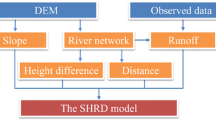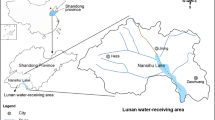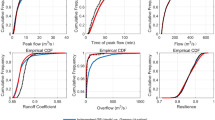Abstract
Water accessibility is an important factor in water use assessments for water users. Water accessibility is affected by climate and socio-economic changes, and notably large regional differences exist. Therefore, understanding water accessibility is essential for effective water management. Based on the length, runoff and viewshed value of each water consumption grid, this paper characterized the corresponding water accessibility using the standardized accumulative probability distribution of the three variables. The Copula function was used to connect the accumulative probability distributions of the three variables and construct a joint distribution. The joint probability distribution was applied to characterize the water accessibility of all of the water consumption grids, and a grid-scale water accessibility evaluation model-LRV (Length-Runoff-Viewshed) was constructed. This paper chose the Yongdinghe River Basin as a case study to evaluate water accessibility using the LRV model. The T Copula function was chosen as the joint distribution function to obtain the water accessibility distribution pattern of the Yongdinghe River Basin. This model obtained the water accessibility of every water consumption grid and provided technical support for refined water resources management.










Similar content being viewed by others
References
Amirataee B, Montaseri M, Rezaie H (2018) Regional analysis and derivation of copula-based drought severity-area-frequency curve in Lake Urmia basin, Iran. J Environ Manag 206:134–144
Chen XX, Chang QR, Guo BY, Zhang X (2013) Analytical study of the relief amplitude in China based on SRTM DEM data. J Basic Sci Eng 21(4):670–678
Emiliano PC, Vivanco MJF, Menezes FSD (2014) Information criteria: how do they behave in different models? Comput Stat Data An 69(1):141–153
Ghiglieri G, Carletti A, Pittalis D (2014) Runoff coefficient and average yearly natural aquifer recharge assessment by physiography-based indirect methods for the island of Sardinia (Italy) and its NW area (Nurra). J Hydrol 519:1779–1791
Goel V, Islam MS, Yunus M, Ali MT, Khan AF, Alam N, Faruque ASG, Bell G, Sobsey M, Emch M (2019) Deep tubewell microbial water quality and access in arsenic mitigation programs in rural Bangladesh. Sci Total Environ 659:1577–1584
Han C, Liu SG, Guo YP, Lin HJ, Liang YY, Zhang H (2018) Copula-based analysis of flood peak level and duration: two case studies in Taihu basin, China. J Hydrol Eng 23(6):05018009-1
Jun C, Qin X, Gan TY, Tung YK, De Michele C (2017) Bivariate frequency analysis of rainfall intensity and duration for urban stormwater infrastructure design. J Hydrol 553:374–383
Karmakar S, Simonovic SP (2008) Bivariate flood frequency analysis: part 1. Determination of marginals by parametric and nonparametric techniques. J Flood Risk Manag 1(4):190–200
Kavianpour M, Seyedabadi M, Moazami S (2018) Spatial and temporal analysis of drought based on a combined index using copula. Environ Earth Sci 77(22):769
Kavousizadeh A, Ahmadi A (2018) High-performance approach for estimating stage-discharge curves in the open channels. J Hydrol 565:197–213
Kim TJ, Wurbs RA (2011) Development of a condensed model for managing of a particular river/reservoir system based on Texas water availability model (WAM) dataset. KSCE J Civ Eng 15(1):205–214
Kusiluka LJM, Mlozi MRS, Munishi PKT, Karimuribo ED, Luoga EJ, Mdegela RH, Kambarage DM (2004) Preliminary observations on accessibility and utilisation of water in selected villages in Dodoma rural and Bagamoyo districts, Tanzania. Phys Chem Earth 29(15):1275–1280
Lewis EW, Siyambango N, Lendelvo S (2018) Assessment of accessibility of safe drinking water: a case study of the Goreangab informal settlement, Windhoek, Namibia. Water Pract Technol 13(4):871–878
Li TY, Guo SL, Liu ZJ, Xion LH, Yin JB (2017) Bivariate design flood quantile selection using copulas. Hydrol Res 48(4):997–1013
Liuzzo L, Noto LV, Arnone E, Caracciolo D, Loggia GL (2015) Modifications in water resources availability under climate changes: a case study in a Sicilian Basin. Water Resour Manag 29:1117–1135
Maliehe M, Mulungu DMM (2017) Assessment of water availability for competing uses using SWAT and WEAP to in south Phuthiatsana catchment, Lesotho. Phys Chem Earth 100:305–316
Nikam BR, Garg V, Jeyaprakash K, Gupta PK, Srivastav SK, Thakur PK, Aggarwal SP (2018) Analyzing future water availability and hydrological extremes in the Krishna basin under changing climatic conditions. Arab J Geosci 11(19):581
Perrin J, Ferrant S, Massuel S, Dewandel B, Marechal JC, Aulong S, Ahmed S (2012) Assessing water availability in a semi-arid watershed of southern India using a semi-distributed model. J Hydrol 460-461(43):143–155
Smiley SL (2013) Complexities of water access in Dar es Salaam, Tanzania. Appl Geogr 41(4):132–138
Sullivan CA, Meigh JR, Giacomello AM, Fediw T, Lawrence P, Samad M (2010) The water poverty index: development and application at the community scale. Nat Res Forum 27(3):189–199
Swain ED, Gomez-Fragoso J, Torres-Gonzalez S (2017) Projecting impacts of climate change on water availability using artificial neural network techniques. J Water Resour Plan Manag 143(12):04017068
Tanzeeba S, Gan TY (2012) Potential impact of climate change on the water availability of South Saskatchewan River basin. Clim Chang 112(2):355–386
Tsakiris G, Kordalis N, Tigkas D, Tsakiris V, Vangelis H (2016) Analysing drought severity and areal extent by 2D archimedean copulas. Water Resour Manag 30(15):5723–5735
Wang LM, Li WJ (2017) Analysis of ecological water status and deficit causes in the mountain area of Yongding River. Haihe Water Resour 38(2):25–28
Wu L, Su XL, Ma XY, Kang Y, Jiang YA (2018) Integrated modeling framework for evaluating and predicting the water resources carrying capacity in a continental river basin of Northwest China. J Clean Prod 204:366–379
Yu GM, Chen XX, Tu ZF, Yu QW, Liu YA, Yu HL (2017) Modeling water accessibility of natural river networks using the fine-grained physical watershed characteristics at the grid scale. Water Resour Manag 31(7):2271–2284
Zhang B, Zhang ZJ, Guo L, Wang H (2013) Key technologies of terrain viewshed analysis based on DEM. Comput Sci 40(9):284–287
Acknowledgments
The authors acknowledge financial support for this work from the National Key R&D Program of China (Grant no.2016YFC0401407) and the National Natural Science Foundation of China (Grant no.51579169; 51879181).
Author information
Authors and Affiliations
Corresponding authors
Ethics declarations
Conflict of Interest
The authors declare that they have no conflicts of interest.
Additional information
Publisher’s Note
Springer Nature remains neutral with regard to jurisdictional claims in published maps and institutional affiliations.
Rights and permissions
About this article
Cite this article
Li, F., Liu, H., Chen, X. et al. Trivariate Copula Based Evaluation Model of Water Accessibility. Water Resour Manage 33, 3211–3225 (2019). https://doi.org/10.1007/s11269-019-02292-x
Received:
Accepted:
Published:
Issue Date:
DOI: https://doi.org/10.1007/s11269-019-02292-x




